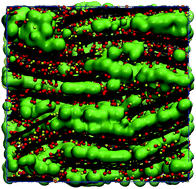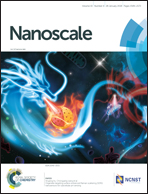Computational characterisation of dried and hydrated graphene oxide membranes†
Abstract
A multi-step molecular dynamics procedure was developed to construct fully flexible atomistic models of graphene oxide (GO) membranes. The method of preparation replicates the experimental synthesis of the material; i.e. the flow-directed self-assembly of individual flakes onto a substrate or filter. A total of 180 GO membrane models were prepared with water contents varying between 0 and 20%, providing an insight into changes in the membrane's interlayer distance with swelling. Membranes with 15% water content have an average interlayer distance (0.80 nm), bulk density (1.77 g cm−3) and tensile modulus (18.1 GPa) in excellent agreement with the experimental literature, demonstrating that air-dried membranes have 15% water content. The models reveal the intrinsic structural heterogeneity and complex morphology of GO membranes. This feature has previously been unaccounted for in both experimental interpretations and GO nanopore models, which often use pre-defined and idealised 2D geometries. Completely dried membranes have considerable free pore volume. This observation explains the modest change in interlayer distance (0.02 nm) as the membrane's water content is increased from 0% to 10% compared to a much more significant change (0.12 nm) as the water content is increased from 10% to 20%. Combined with this new understanding of membrane swelling, the availability of such representative models opens the possibility of the molecular-level design of GO membranes for a variety of applications, such as gaseous and aqueous separations.



 Please wait while we load your content...
Please wait while we load your content...